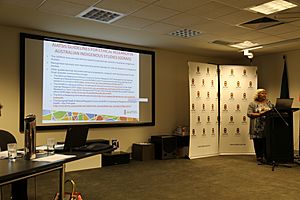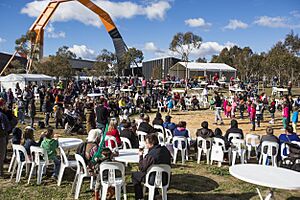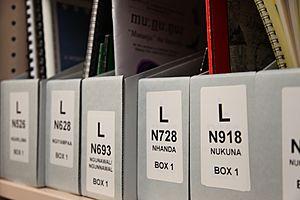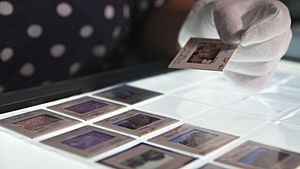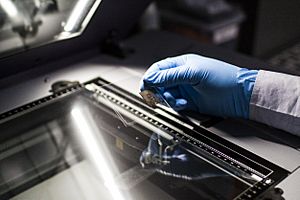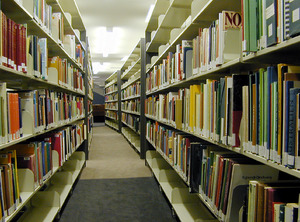Australian Institute of Aboriginal and Torres Strait Islander Studies facts for kids
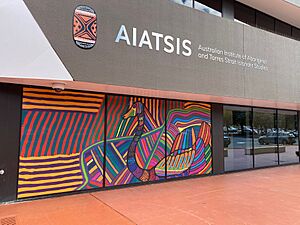
The AIATSIS building in 2023
|
|
| Established | 1964 |
|---|---|
| Location | Acton, Australian Capital Territory, Australia |
The Australian Institute of Aboriginal and Torres Strait Islander Studies (AIATSIS) is a special Australian Government group. It started in 1964 and is Australia's main place for learning about the cultures and societies of Aboriginal and Torres Strait Islander peoples.
AIATSIS collects, publishes, and does research. It is known for doing research in a way that respects cultures and handles sensitive information carefully. Over 50 years, AIATSIS has built a huge collection by working with Aboriginal and Torres Strait Islander communities. This collection helps bring back languages and cultures, supports Native Title research, and helps people find their family history. You can find AIATSIS in Canberra, Australia.
Contents
History of AIATSIS
How AIATSIS Began (1959–1964)
In the late 1950s, people around the world started to worry about "disappearing cultures." In Australia, researchers wanted to learn more about Aboriginal and Torres Strait Islander peoples. In 1959, a politician named W.C. Wentworth suggested creating the Australian Institute of Aboriginal Studies (AIAS).
He wanted the Australian Government to do more to record the cultures of Aboriginal and Torres Strait Islander peoples. In 1960, a group at the Australian National University (ANU) looked into this idea. They asked W.E.H. Stanner to organize a meeting in 1961 about Aboriginal Studies in Australia. Many academics attended this meeting.
In 1961, the Prime Minister, Robert Menzies, set up a temporary council. This council planned how the new research group would work with other science and research places. They also started to find urgent research needs right away. Professor A. D. Trendall was the first leader of this council.
In 1962, they wrote a plan for the institute, which was approved in 1963. This plan helped create the new Australian Institute for Aboriginal Studies the next year.
Early Years of AIAS (1964–1970)
The Australian Institute of Aboriginal Studies (AIAS) officially started in June 1964. Its main goal was to record languages, songs, art, and traditions before they were lost due to European ways of life.
The Institute's main jobs were:
- To support scientific research on Australian Aboriginal peoples.
- To quickly study things that were disappearing.
- To create a center with books and materials for scholars and the public.
- To encourage researchers to work together.
- To publish research findings.
- To help fund research and protect important cultural sites.
- To train new researchers.
- To work with international groups.
AIAS had a council of 22 members, mostly academics. Frederick McCarthy, an anthropologist, became the first leader. He believed film was important for research. The AIAS Film Unit started making many films about different cultures.
The Institute also started a publishing group in 1964. They published many papers and research findings on topics like languages and history. The early work of AIAS helped create the huge collections that AIATSIS has today. However, before 1970, no Aboriginal or Torres Strait Islander people were on the AIAS Council.
Self-Determination and Change (1970–1989)
The 1970s brought big changes to AIAS. In 1970, Phillip Roberts, an Alawa man, became the first Aboriginal person on the AIAS Council. More Aboriginal and Torres Strait Islander people joined the council later, including Senator Neville Bonner and Dick Roughsey.
Aboriginal activists wanted more involvement in how Aboriginal Studies were run. They felt that their voices were not heard enough. The Aboriginal rights movement was growing, and people demanded more control over research about their cultures.
In 1972, the new government supported "Self-determination" for Aboriginal people. This meant more funding for AIAS and more Aboriginal involvement. Peter Ucko became the new leader in 1972. He started a policy called "Aboriginalisation," which aimed to open up the institute to Aboriginal people.
In 1975, the Aboriginal Advisory Committee was created. This committee pushed for more Aboriginal people to be on committees and work at the institute. In 1975–1976, special research grants were introduced for Aboriginal researchers.
The AIAS Film Unit moved to Canberra in 1975. Filmmakers David MacDougall and Judith MacDougall and Kim McKenzie led the unit. They changed how films were made, focusing on telling individual stories and working closely with the people in the films. They used subtitles so people could hear the subjects' own voices.
In 1978, activist Marcia Langton spoke about the need for Aboriginal people to tell their own stories through film. By the early 1980s, the AIAS Film Unit started training Aboriginal filmmakers.
The Institute also began the biennial Wentworth Lecture in 1978, honoring W.C. Wentworth. This lecture features important people who speak about issues affecting Aboriginal and Torres Strait Islander peoples.
In the 1980s, AIAS continued to grow. The Aboriginal Studies Press started publishing the Australian Aboriginal Studies Journal in 1983. In 1985, the After 200 Years project began. It aimed to collect more photos of daily life for Aboriginal and Torres Strait Islander people, especially in cities. Aboriginal people helped choose and document these photos.
The Rock Art Protection Program (RAPP) started in 1986 to protect Australian Indigenous rock art. By 1987, the AIATSIS library had grown to include print, special research materials, and audiovisual items.
Between 1987 and 1989, there were talks about combining AIAS with a new government group. However, AIAS remained separate and was renamed under a new law.
AIATSIS Today (1989–Present)
In 1989, the Australian Institute of Aboriginal and Torres Strait Islander Studies (AIATSIS) Act was passed. This new law changed the name to AIATSIS and made sure that at least five of the nine Council members were Aboriginal or Torres Strait Islander people.
In 1996, the Aboriginal Studies Press published their popular Aboriginal Australia map. This map was based on research for the The Encyclopaedia of Aboriginal Australia.
Since 2001, AIATSIS has worked on making its collections digital. They scanned old magazines like Dawn and New Dawn, and the entire collection of the Koori Mail newspaper. This makes these important historical documents available online.
AIATSIS also hosts important events. Since 2001, they have held the National Indigenous Studies Conference every two years. Since 2002, they have held the National Native Title Conference every year.
In 2014, the After 200 Years photo project was shown again in an exhibition to celebrate AIATSIS's 50th anniversary.
On 2 February 2024, AIATSIS opened a new center in Mparntwe-Alice Springs. This center helps local people take care of their cultural heritage and provides access to AIATSIS materials for people in Central Australia.
How AIATSIS is Run
Laws and Purpose
AIATSIS is a government organization that follows the Public Governance, Performance and Accountability Act 2013. It works under the Department of the Prime Minister and Cabinet. The Minister for Indigenous Australians, Hon Linda Burney, is in charge.
The main law for AIATSIS is the Australian Institute of Aboriginal and Torres Strait Islander Studies Act 1989. This law explains what AIATSIS does:
- To do and encourage studies about Aboriginal and Torres Strait Islander peoples.
- To publish and help publish these studies.
- To do research and encourage others to do research in these areas.
- To help train people, especially Aboriginal and Torres Strait Islander people, as researchers.
- To create and keep a collection of cultural materials related to these studies.
- To help everyone in the community understand Aboriginal and Torres Strait Islander societies better.
The Council
The AIATSIS Council guides the institute. It has nine members: four are chosen by the institute's members, and five are chosen by the Minister. At least five members must be Aboriginal or Torres Strait Islander people.
Some past leaders of the Council include:
- A.D. Trendall, 1961–1966
- Neil William George Macintosh, 1966–1974
- Les Hiatt, 1974–1982
- John Mulvaney, 1982–1984
- Ken Colbung AM MBE, 1984–1990 (the first Aboriginal leader)
- Marcia Langton AM, 1992–1998 (the first Aboriginal woman leader)
- Mick Dodson AM, 1999–2017
- Michael McDaniel, 2017–2019
- Jodie Sizer, 2019–present
Committees
AIATSIS has different committees that help the Council and the Chief Executive Officer (CEO). These include groups like the Audit and Risk Committee, Collections Advisory Committee, and the Research Advisory Committee.
The Indigenous Caucus is a group for Aboriginal and Torres Strait Islander staff to discuss workplace issues. It helps make sure the organization is culturally aware and supports Indigenous staff.
The Native Title Research Advisory Committee (NTRAC) gives advice on research about Native Title. The Research Ethics Committee (REC) makes sure all research is done in a fair and respectful way.
Staff
Leonard Hill is the Chief Executive Officer (CEO) of AIATSIS.
Research at AIATSIS
What AIATSIS Researches
AIATSIS has been doing research for over 50 years. They study many topics important to Indigenous peoples, their culture, history, and experiences. This includes languages, archaeology, land rights, and modern topics like health.
The AIATSIS collections are very important for research. They hold valuable records of Australia's Indigenous cultural heritage. AIATSIS is one of Australia's main research agencies, and it's the only one focused on non-science areas.
AIATSIS currently focuses on six main research areas:
- Native Title and traditional ownership
- Land and Water
- Government and public policy
- Languages and Cultural Expression
- Health and Wellbeing
- Education and cultural learning
Doing Research Ethically
AIATSIS is a leader in doing research in a way that is fair and respectful, especially with culturally sensitive materials. They have many unique and important cultural items.
In 1999, AIATSIS published Guidelines for Ethical Research in Australian Indigenous Studies (GERAIS). These were the main rules for doing research with Indigenous communities in Australia. In 2020, GERAIS was replaced by the AIATSIS Code of Ethics for Aboriginal and Torres Strait Islander Research. This new code has four main principles:
- Indigenous self-determination (Indigenous people making their own decisions)
- Indigenous leadership
- Impact and value (research should be helpful and important)
- Sustainability and accountability (research should be long-lasting and responsible)
Native Title Research
AIATSIS started doing Native Title research in 1993, after the important Mabo v Queensland court decision in 1992. Native Title research helps understand land rights and traditional ownership.
AIATSIS studies many things related to Native Title, like cultural heritage and how Native Title groups are run. They also publish books and reports about Native Title. AIATSIS helps Native Title claimants get materials from their collections to support their claims.
Since 2021, the National Native Title Conference has joined with the National Indigenous Research Conference to create the AIATSIS Summit. This big event includes a special part for Native Title and a youth forum.
Family History Research
AIATSIS has resources to help people research their own family history, especially for Aboriginal and Torres Strait Islander heritage. They have a Family History kit that guides people on how to use AIATSIS resources and other tools.
They also help Link-Up workers who assist members of the Stolen Generations to reconnect with their families and heritage.
Publishing at AIATSIS
Aboriginal Studies Press
AIATSIS publishes research through its publishing group, Aboriginal Studies Press (ASP). They started publishing in 1962. ASP publishes many types of books, including research reports, biographies, family histories, and children's books.
They publish books by both Aboriginal and Torres Strait Islander authors and non-Indigenous authors who write about Aboriginal and Torres Strait Islander Studies. All books are reviewed by experts.
Important Publications
The Australian Aboriginal Studies (AAS) is a journal published twice a year by Aboriginal Studies Press since 1983. It has articles and book reviews.
The Little Red Yellow Black Book, first published in 1994, is a well-known educational resource. Another important publication is the Aboriginal Australia map, created by David Horton. This map shows the general locations of larger Aboriginal groups.
Stanner Award
ASP also publishes the winner of the Stanner Award. This award is for scholarly writing by an Aboriginal or Torres Strait Islander person. It helps new academics get their work published. The award is named after anthropologist W. E. H. (Bill) Stanner, who helped start AIAS.
Past winners include Auntie Rita (1996) by Rita Huggins and Jackie Huggins, and Broken circles: Fragmenting indigenous families 1800–2000 (1999) by Anna Haebich.
AUSTLANG Database
The AIATSIS website has the AUSTLANG database. This is a great source of information about all known Aboriginal Australian languages. It started as a card file in the 1990s and became an online database in 2008, with a new version released in 2018.
Events and Gatherings
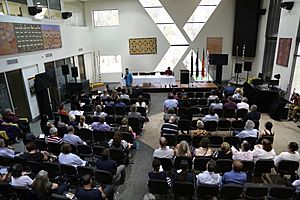
AIATSIS hosts many special events, workshops, and conferences.
Past Events
- NAIDOC on the Peninsula was a free community event held in Canberra during NAIDOC Week from 2006 to around 2014. It celebrated the cultural heritage of Aboriginal and Torres Strait Islander peoples with music and activities.
- The National Native Title Conference (NNTC) was an annual or every-two-year conference that focused on Native Title.
- The National Indigenous Research Conference (ANIRC) was held every two years to share knowledge in Indigenous studies.
Current Events
- The AIATSIS Summit started in 2021. It combines the National Native Title Conference and the National Indigenous Research Conference into a five-day event. It includes a special part for Native Title and a youth forum.
- The Wentworth Lecture is held every two years. It encourages Australians to better understand important issues for the nation.
Location and Building Design
Canberra Building

AIATSIS is located on the Acton Peninsula in Canberra. Its current building opened in 2001. At the opening, the Ngunnawal people, who are the traditional owners of the land, performed a Welcome to Country and smoking ceremony.
The architect, Howard Raggatt, designed the building. He changed the original plans to save two important trees. The building cost $13.75 million. The design of the building has been described as looking like a black copy of the famous Le Corbusier's Villa Savoye in France. It is also said to remind people of Sidney Nolan's paintings of Ned Kelly.
A new AIATSIS building is planned for a new area in Canberra called Ngurra, which means "home" or "a place of belonging" in several Aboriginal languages. This new area will also have a learning center and a resting place for ancestral remains of Aboriginal and Torres Strait Islander people.
AIATSIS Central Australia
A new AIATSIS center called AIATSIS Central Australia opened on 2 February 2024 in Alice Springs/Mparntwe. It helps Aboriginal and Torres Strait Islander people in Central Australia access AIATSIS materials and care for their cultural heritage.
Collections at AIATSIS
What's in the Collection?
AIATSIS is Australia's top place for information about Aboriginal and Torres Strait Islander cultures. It is the only government group responsible for collecting and keeping materials about the spoken and visual traditions and histories of these peoples. The collection is a "keeping place for culturally significant objects."
The collection holds thousands of years of history and represents over 500 Australian Indigenous languages and groups. In 2024, it was estimated to have over a million cultural items. This includes 42,000 hours of audio, over 700,000 photographs, and about 6 million feet of film.
Some very important items in the collection include:
- The Australian Indigenous Language Collection: This collection of printed materials in Aboriginal and Torres Strait Islander languages is recognized by UNESCO as unique. It includes 200 of the estimated 250 languages spoken before European settlement.
- Sorry Books: AIATSIS holds 461 Sorry Books, which have hundreds of thousands of signatures and messages from the 1998 campaign. These books show people's personal responses to the history of the Stolen Generations.
- Luise Hercus recordings: These recordings, made between 1963 and 1999, include over 1000 hours of 40 endangered Aboriginal languages.
The collection is organized into these main groups:
- Art and artefact: About 600 artworks and 500 artefacts, from the late 1800s to today.
- Books and printed material: Over 175,680 titles, including books, magazines, and government reports.
- Film: Over 8 million feet of film and 4000 videos, including many made by the AIAS Film Unit.
- Manuscripts and rare books: Over 11,700 manuscripts and 2,600 rare books, some from 1766. These are kept in special, secure storage. This includes the Sorry Books.
- Pictorial: About 650,000 photographs, dating back to the late 1800s. Most of these images are unique to AIATSIS.
- Sound: About 40,000 hours of unique sound recordings. These include languages, ceremonies, music, and interviews about important events like the 1965 Freedom Rides.
Adding to the Collection
AIATSIS gets new items through donations, gifts, purchases, or from researchers and filmmakers funded by AIATSIS. They also accept "deposits," where original owners can set rules for how their cultural information is used.
AIATSIS collects items based on three main ideas:
- Completeness: They try to collect as much as possible.
- Importance: They look for items that contribute to worldwide knowledge, relate to AIATSIS research, are valued by Indigenous communities, or are rare.
- Representation: They collect items that show a good example of a certain type of creativity or research.
Managing the Collection
AIATSIS works hard to keep its collection safe. They record and catalogue items, store them properly, and convert old formats to new ones (digitization).
They protect physical items by checking for insects and mold, and storing them in climate-controlled rooms. They follow international rules for storing and preserving materials.
Many old photos, tapes, and films are at risk of damage. AIATSIS digitizes these items to save their content for the future. For digital items, they sometimes print them out as an extra way to preserve them.
AIATSIS also holds sensitive or secret/sacred materials. They follow strict rules when handling these items to respect Aboriginal and Torres Strait Islander cultures. Restricted items are stored separately and handled carefully during digitization.
Digitization Program
AIATSIS started its Library Digitisation Pilot Program in 2001. Since then, they have continued to digitize their collection. They prioritize items that are very important, damaged, culturally sensitive, or in high demand. One main goal is to digitize all audiovisual materials on old magnetic tapes by 2025, as set by UNESCO.
Accessing the Collection
The AIATSIS Library is open to the public. You can find printed materials like books, journals, and maps there. You can access films, sound, and photos by making an appointment.
The digitization program helps more people access the collection, especially those in remote Aboriginal and Torres Strait Islander communities.
AIATSIS has a program called Return of Material to Indigenous Communities (ROMTIC). This program gives Aboriginal and Torres Strait Islander people copies of collection materials related to their language group or family.
AIATSIS also shares parts of its collection through online exhibitions on its website. These include:
- A.M. Fernando Notebooks: Notes from an Aboriginal man living in London in the 1920s.
- Remembering Mission Days: Materials about old missions.
- 1967 Referendum: Information about the 1967 vote to change the Australian Constitution.
- Freedom Ride: Photos and diaries from the 1965 Freedom Ride in NSW.
- From Wentworth to Dodson: A timeline of AIATSIS history.
- Dawn/New Dawn: A complete set of magazines published by the NSW Aborigines Welfare Board.
- Koori Mail: The full collection of this Aboriginal-owned newspaper.
- To Remove and Protect: Old Australian laws that controlled Aboriginal lives.
- Sorry Books: Messages of apology to the Stolen Generations.
Access to the collection is also guided by laws and agreements. The AIATSIS Act says that information given with restricted access can only be shared according to those rules. It also says that information should not be shared if it goes against the views of Aboriginal or Torres Strait Islander people.
AIATSIS also follows the Copyright Act (1968). They acknowledge the United Nations Declaration on the Rights of Indigenous Peoples, which says Indigenous people have the right to control their cultural heritage.
To handle these complex issues, AIATSIS created an Access and Use Policy in 2014. This policy helps manage legal and cultural rights while making the collection as accessible as possible.
Collection Resources
AIATSIS has created resources to help people find items in the collection. One important resource is the Aboriginal and Torres Strait Islander Biographical Index (ABI). This index lists names of Aboriginal and Torres Strait Islander people from published materials.
Mura is AIATSIS' online collection catalogue. Mura is a Ngunnawal word meaning "pathway." You can search Mura to find items in the collection.
The Photographic Collection has about 400,000 digitized images. For copyright and cultural reasons, many images can only be viewed at AIATSIS, but you can request copies.
AIATSIS also works with other online resources like Trove, where you can search the AIATSIS collection. They also have Pathways Thesauri, which helps you find items by languages, place names, and study topics.


